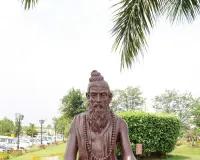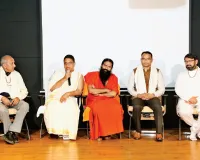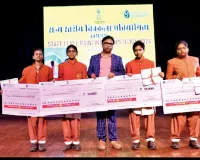Vedic sacrifices
On

Swami Yagyadev
Patanjali Sanyasashram
Vedik literature, Yagya has been considered as the metaphor of the navel of the world. The place of the navel is very important in the human body. In the Upanishads, only the navel is described as the center of human birth or death. Just as the body deteriorates due to deterioration of the navel or the body remains healthy when the navel is fine, similarly there is a place of Yagya in the universe. In Rigveda, the navel form of Yajna has been inaugurated by the sage Dirghatamsa in Drishtasukta through question and answer. According to Sayanacharya, on the first day of the Ashwamedha Yajna, there is a question-and-answer episode by Brahma with the host-
..... Prichchhami Yatra Bhuvanasya Nabhih I
..... I ask where the navel of the world is. ' What is the center where everything is bound together? When asked in this way, the priest replies with the next mantra:
.... Ayam Yagyo Bhuvanasya Nabhih l
This sacrifice is the navel of the world. Here the commentator Sāyana has a special saying: Ayam Yagya Bhutajatsya Sannahanam l Tatraiva vrishtiyadisarvaphalotyatpatte Sarvapraninam Bandhakatvata l Since the birth of all living beings is bound by the origin of rain and other fruits, this sacrifice is the life-support of the living being.
Swami Dayananda Ji has interpreted this verse as Yajna Geography is going to bind the group by attraction.
The Samhita writers have also called yagya mahurbhu-vanasya nabhim 'yajna as the navel of Bhuvan'. From this, the description of the entire Charachar world and the world form has been done in a figurative manner, as--
Yatpurushena Havisha Deva Yagyamatanvata I
Vasanto Asyadidajyam Grishma Idhmah Shraddhavih II
Tasmadyagytsarvahutah Sambhrih Prishadajyam l
Pashuntamshchakre Vayavyanaranyangramyashcha Ye ll
Researchers on Purusha Sukta have written explaining the meaning of the Mana Mantras: 'At the time of sunrise, the Sarvahuta Yajna itself is offered by the Purusha to the Yajmana, the Devas to the Ritvijas, the Spring to the Ajyas, the Summer to the Samidha, the Autumn to the Havi acted as a peacock. The gods have men was tied and Srishti Yagya was started. In its imitation, Yagyas from Agrihotra to Ashwamedha were conceived. In Vedic literature, Yagya has been given the noun of Devarath. As-
Yadyagyo Manushya Rathenaiva Devrathambhya-tishthati II Man is mounted on the chariot of the gods by the sacrifice performed.
Aish Vai Devratho Yada Darshapurnamashau ll This is the chariot of the gods that is in the full moon of the darsha. This which is the Darshapurnamasa Yajna.
Devratho Wa Aesha Yada Yagyah, Yagyo Waw Devrathah II That one which is Yagya is in fact Devratha.
Yagya not only carries the natural forces but also adapts them. That's why the ancient sages have presented Yajna in the form of Devrath. Where yagya is a form of wealth, it is also an enhancer of wealth. as-
Yajna hi ta Indra vardhanall It certainly enhances wealth.
Deva Yagyamatavant ..... Indriyay ll " The best wise men are the ultimate wealth expand the soothing yagya for.
Vasu Yajna Vasumana Yajna, Yajna Vai Vasu ll This is the form of wealth in the world. The luminous form of sacrifice is described in the Rig Veda.
Jyotiryagyasya Pavate Madhu Priyam Pita Devanam Janita Vibhuvasuh ll Vibhuvasu. "The sweet light of Yagya purifies the world and worlds. The language of the said mantra recited in Samaveda has been interpreted as - 'The light of Yagya is the protector of the gods like Vayu, they give birth to rituals and are extremely opulent.
Jyotirvai yajnah " The sacrifice is light.
Viraja Jyotisha Saha " (Dharmao Vibhati) With the Virat Jyoti, the sacrifice shines. The ancient sacrificial scientific sages have pointed out the importance of sacrifice by pointing to the necessity of sacrifice. Swaha Yagyam Krinotana - In the first mantra of the Yajurveda, recited by Rishi Parameshthi Prajapati, prarpayatu shreshthamaya karmene. Of the language commentary 'The life has been devoted to the most beneficial sacrifices and other deeds worthy of excellence and the second it is going to happen. Yagya Pavitramasi - is the cause of purity.
Dayorasi - Cause of the light of science and located in the rays of the Sun.
Prithvivyasi- Spreads all around with air.
Matrishvano Dharmoasi- Purifies the air.
Vishvadha Asi- Contains the world.
Paramen Dhamra Hasva - is the one who increases happiness from the best place never renounce it. And Swami Dayananda Saraswati wrote, interpreting it:
Vaso Pavitramasi Dyayorasi Prithivyasi Matarishvano Dharmoasi Visvadha’asi.
Paramena Dhanmra Hrihasva Ma Hvarma Te Yagyapatirhvarshita ll
O man of knowledge! Thou who art the cause of sacrificial purification, who is the light of science and who is steady in the rays of the sun, who spreads with the wind in countries and countries, who purifies the air and the world. The one who wears and who increases happiness in the best place. You don't abandon this Yagya and the host who protects your Yagya should also not abandon it.
In the Brahmin texts, the importance of Yagya by calling it the best action is emphasized. as-
Yagyo Vai Shreshthatam Karma, Yagyo hi shreshthatamam karm I " The Upanishads mention Yajna merely as Agrihotra and explain its importance. e.g.
Aeteshu Yashcharate Bhajmaneshu Yathakalam Chahutyodyadadayan l
Tannayantyetah Suryasya Rashmyo Yatra Devanam Patirekoadhivasah ll
In the crests of fire with seven flames which the host just time But by giving sacrifices, he completes his work. These sacrifices reach him in the rays of the sun and reach there in the form of accumulated karma. Where God is known personally on the basis of the world.
Yatheha Kshudhita Bala Mataram Paryupasate l
Aevam Sarvani Bhootanyagrihotramupasat ll
In this world, like hungry children beg for happiness from their mother. All such beings worship the Agnihotra (sacrifice).
Yena Sadanushthanena Sampurnavi Shvam Kalyanam
Bhavedadhyatmikadhidaivika dhibhautikata patrayonmoolanam Sukram Syat Tata Yagyapadabhidheyama
The ritual by which the welfare of the whole world is done and the eradication of all the three sins, spiritual, spiritual and spiritual, is called Yagya.
Sarvasmatpamanonirmuchyate Sa Ya Aevam Vidwanagnihotram Juhoti II
The one who performs Yagna becomes free from all sins.
Yagyashishtashina Santo Muchyante Sarvakilvishaiah I
Bhunnate Te Tvaghana Papa Ye Pachantyatmakaranat II
One who eats the leftover food after Yagya that means one who purifies the nature becomes free from all sorts of sins. One who does not do this becomes ill.
Yagyadananatapakarma Na Tyatyam Karyameva Tata I
Yagyo Danam Tapa Shchaiva Pavanani Manishinam II
Yagya, giving alms and penance should not be avoided and must be embraced. Because they make a wise man pure.
Agnau Prastahuti Samyagadityamutishthate I
Adityajnayate Vrishtirvrishternnam Tata Prajah II
The offering of things like clarified butter, herbs, etc. properly thrown into the fire is received by the sun and it mixes with the sun's rays and exerts its effect on the atmosphere; of human beings there is nurturing.
In the first half of the 20th century, Veda commentator Pt. Raghunandan Sharma has shown the importance of Yajna which is widespread and prevalent in the world. As- the whole world had accepted the Yagyas and till now the world they are prevalent in almost all sects. Max Muller has also accepted this in his Physical Religion. In all the religions, whether new or old, which were and are prevalent in the world, one or the other form of Yagya has been accepted. Yagya was prevalent in all the ancient branches of Aryans. In ancient times, Yagya was also prevalent in the Greeks and Romans. Yagya is still prevalent among Parsis and Vedic Aryans. Dhoop-lamp, which is the residual and subtle form of Yajna, is prevalent in Jains. This is the matter of the Aryan branch, the Semitic branch also has three religions at this time - Jewish, Christian and Muslim. Out of these, the Jews used to have yagya here, they used to call the kund 'Ker'. Even among Christians and Muslims, the custom of burning udbati and frankincense etc. still exists. Even though they don't have form. In this way, this second Semitic branch of human race has also been following Yajna from ancient times (Puratan) till now (Adhunatan). Historical evidence of Yajna is also found in the third old branch. The Chinese call the Yagya 'Ghom', which is nothing but Home. In this way, Yagyas used to happen and are happening in all the three divisions of the human race. The practice of Yajna continued in the ancient castes of Egypt and the Red Indians of America. It is meant to say that Yagya is the primitive religion of man.
Other scholars have also pointed to the scientific importance of Yagya have done As revealed in the Vedas, the entire science in the form of Yagya has gone. like without the help of a laboratory current science cannot be taught only by books, similarly, the education of Vedic science without Yajnashalas remains incomplete. The principles of science which are known in Veda mantras they exist, they can be used only through Yagyas. This sacrifice there are two types - a Prakrit Yajna, which is continuous in nature and the second ritualistic or artificial sacrifice, which is performed by human beings goes. Prakrit Yagya is the basis of this artificial Yagya. Prakrit the principles of science are explained in Yagya and in the ritualistic Yagya and the use.
'Yagya' is the center of all our Yogakshem. The representative of Yagya is Agni. Fire is considered to be the pinnacle of human invention. Physical science is only the practice of nature, but the science of sacrifice is the practice of both nature and man.
Benevolent
In the Rig Veda, the importance of Yajna Hu is mentioned while wishing for welfare from Agnihotra and other sacrifices. May the sacrifices be peaceful, the sacrifice of Havan be benevolent.
Elsewhere, Vaishvanara is the deity of fire and the importance of the science of sacrificial fire is stated in the mantra. as-
Yam Devaso Ajanayantagni Yasminnajuhuvurbhuvanani Vishva I
So Archashi Prithivim Dyamutemamrijooyamano Atapanmahitva II
The scholar of Vedic science wrote in the explanation of this mantra is- the sacrificial fire which the knowers of the science of sacrifice produce and offer sacrifices of various medicinal elements in it for the welfare of the world. His flame, heat and radiance purify the earth and space worlds and keep their influence brilliant by their power. The Puranas have also considered sacrifice as auspicious. For example,
Yageyanaashyayita Deva Vrishyatsargena Manavah I
Aapyayanam Vai Kurvanti … Yagya … Kalyanahetavah II
Satisfied by Yagya, the Gods satisfy humans with rain etc. Yajna is for the welfare purpose.
Ayudharak
The Samhita and Brahmana authors have related the weapon-bearing importance of the sacrifice are briefly highlighted. as-
Yagyenasma (Yajamanaya) Aayurdadhati … Sarva Va Aete – (Ritvijah) Asmai Chikitsanti II
Ritwiggan treats the host through the sacrifice and in that makes you imbibe age.
Yadagnaye Shuchaye (Nirvapati) Ayurevasmina Tena Dadhati II
By the oblation which is offered in the sacred fire the life of the priest, the sacrifice gives life. or (the host gets life).
Yagyo Me Aayurdadhatu -- May the sacrifices give me life.
Yagyo Va Ayuh - Yagya is the life.
लेखक
Related Posts
Latest News
01 Dec 2024 18:59:48
योग प्रज्ञा योग - योग जीवन का प्रयोजन, उपयोगिता, उपलब्धि, साधन-साधना-साध्य, सिद्धान्त, कत्र्तव्य, मंतव्य, गंतव्य, लक्ष्य, संकल्प, सिद्धि, कर्म धर्म,...



.jpg)












.jpg)




